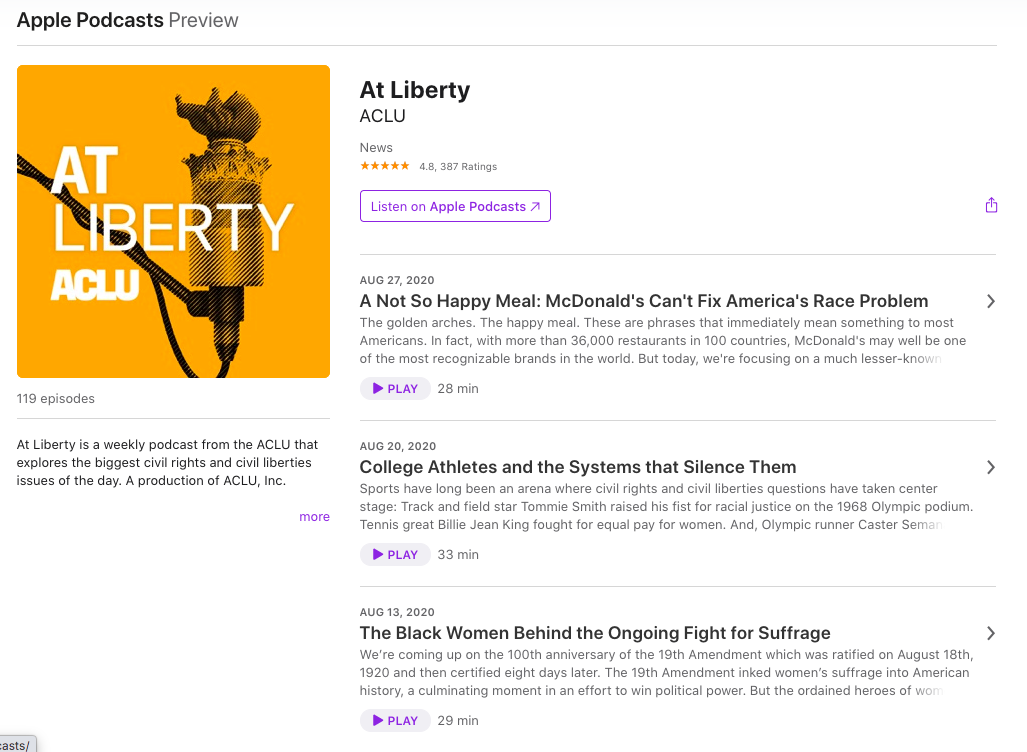Emotional marketing is one of the best ways to connect with consumers and keep their attention in an ever-more-crowded advertising landscape.
our own research at Fractl found that strong emotional hooks were the single biggest predictor of success in content marketing campaigns, regardless of the vertical.
Great emotional marketing does so much more than sell — it inspires, it spurs to action, and it puts you in the center of a conversation that’s bigger than just your core product or business.
In this guide, we’ll explore why emotional marketing is so powerful, look at emotional marketing research that demonstrates its value, and cover how making an emotional appeal to your target audience can first get their attention and then win their loyalty.
What is Emotional Marketing?
Allie Decker defines emotional marketing as, “marketing and advertising efforts that primarily use emotion to make your audience notice, remember, share, and buy.”
But why does this work so well, and why is it important for your brand?
Emotions are constantly coloring and shaping the way we perceive what’s going on in the world around us.
For example, depending on our emotional state, we may experience and remember the same event in vastly different ways. Plenty of research has shown that emotions affect almost everything, from how we remember events to how we visually perceive the world.
Of course, being perceived a certain way and being memorable are core tenets of any marketing campaign, and emotional marketing is certainly one of the best ways to achieve these connected aims.
Which Emotions Work Best for Emotional Marketing?
Every language and culture has plenty of different words for emotions: Happy, sad, excited, disgusted, elated, glum, euphoric, depressed.
In reality, though, all of these labels exist on a spectrum defined by two basic categories: valence and arousal.
Valence is about whether something is seen as positive or negative. Arousal is closely linked but different: It describes whether something is exciting or calming. Importantly, a “strong” emotion can happen at any combination of the extremes of these scales, and emotions can be understood as all having some level of these two aspects.
Dr. James A. Russel’s influential chapter on measures of emotions broke this down with a simple visualization (treating valence as pleasant vs. unpleasant and arousal as activation vs. deactivation).
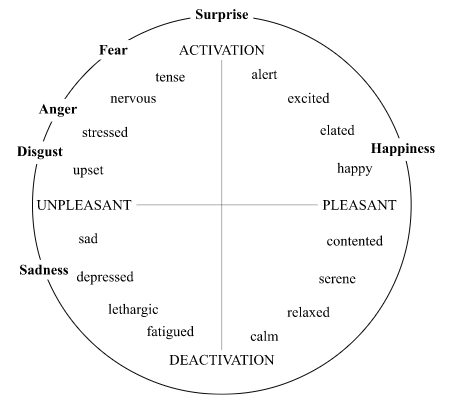
Graphic: Stanford Encyclopedia of Philosophy
For emotional marketing, the action happens in the top half of this chart: People in an activated state are more likely to engage and remember something.
While it may be intuitive to think an emotional marketing campaign should fall in the high-activation, high-pleasantness side, that’s not always the case.
The key takeaway for emotional marketing is that, positive or negative, the emotions you aim for need to be strong ones, and they need to be brought about intentionally.
It won’t be often that brands intentionally go for negative emotions, though sometimes anger or sadness can be productive when you’re trying to inspire people to take action.
For example, ACLU’s At Liberty podcast talks about some of the toughest issues in America. As a nonprofit they often want to encourage people to sign petitions, donate, or take other actions to help various causes.
While some accounts may cause listeners to feel angry, sad, or other negative emotions, it’s done in the name of informing and inspiring people to help make things better.
How to Create an Emotional Marketing Campaign
You start by doing extensive emotional marketing research on your target audience. You need to know who they are and what makes them tick.
Not doing the legwork up front carries the risk of either eliciting a lot of unintended emotions or eliciting no strong emotions at all, becoming instantly forgettable.
One of the biggest mistakes marketers make when trying to create emotional content is to assume that emotional reactions are universally the same and not the messy, difficult-to-predict spectrum of responses we actually see in the real world.
A campaign that inspires one target audience may make another audience feel targeted and judged; an ad intended to be humorous may make one target audience roll on the floor in laughter while provoking a swift negative response from another. Nike likely knew this would happen but projected they’d benefit. You need to make the same judgment calls.
Ultimately, to make the best decision for your brand, emotional marketing research hinges on understanding the problems, issues, concerns, and sources of pride for your audience.
There are a few ways to do this.
Keyword Research
One of the best ways to understand an audience is through keyword research: In a nutshell, knowing what your audience is searching for online can give you tremendous insight into who they are and what they’re looking for on the web.
Tools like BuzzSumo, SEMrush, and Answer the Public provide ample resources for doing basic and advanced keyword research, giving detailed results on the most relevant searches, related terms, news articles, influencers, and sharing metrics that can give you a much better sense of where a product or brand stands in the current culture.
Say, for example, you know you want to create content somewhat related to Thanksgiving dinner, but you don’t know what angle to take or what emotions to go for. You might start by thinking that cooking a Thanksgiving dinner can be stressful in itself, as turkeys can be tricky, and there are so many side dishes to prepare.
However, a quick search in BuzzSumo’s Questions feature reveals a variety of other emotions associated with the evening.
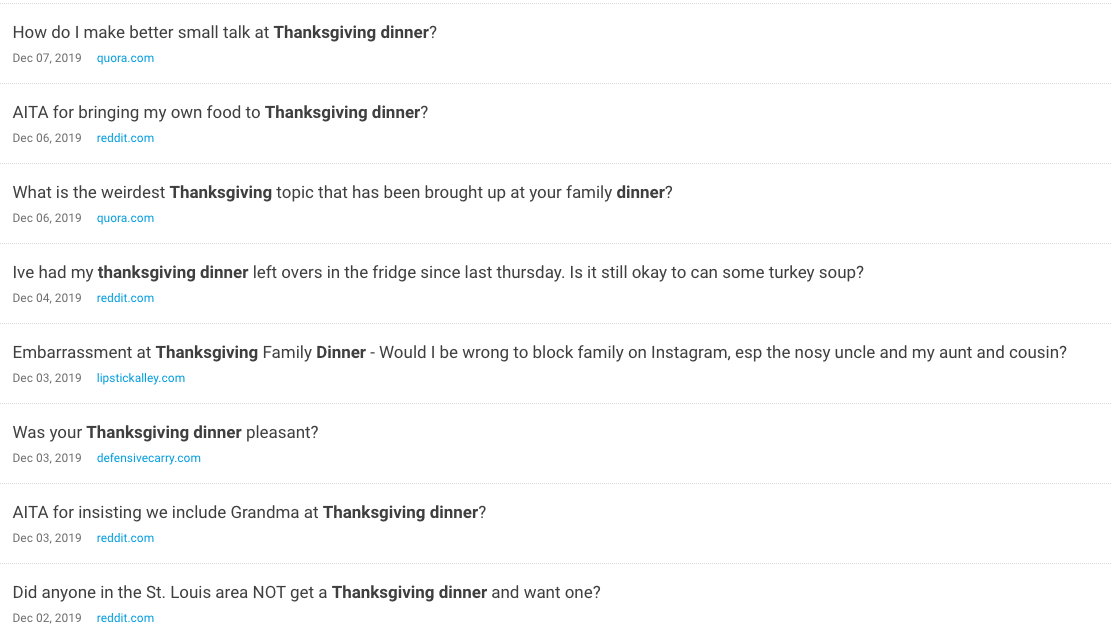
There’s anxiety about the social interaction Thanksgiving involved. There’s worry over the proper etiquette and how your actions might affect others. There’s the loneliness of those who have no where to go for Thanksgiving, and the heartwarming kindness of offering a dinner to those who need it.
As you can see, doing the initial research can help you unlock many emotions associated with your general idea, allowing you to choose the one you can best create content around.
Target Audience Research
Target audience research is a more involved process that often involves creating buyer personas — hypothetical people who you define as representative of your target audiences.
Tools like Facebook’s Audience Insights and SparkToro provide nuanced options for narrowing a target audience by basic demographics like age and gender or online behavior, like which news websites they visit or who they follow on social media.
This allows marketers to hone in on the preferences and habits of the people they hope to reach, and by seeing what the audience is already engaging with, it becomes easier to understand the sort of emotional appeals that have a proven track record of getting attention and earning business.
For example, if your target demographic is men 18-25 years old who like comics, Facebook Audience Insights shows you other brands they’re likely to be interested in based on their Page likes.
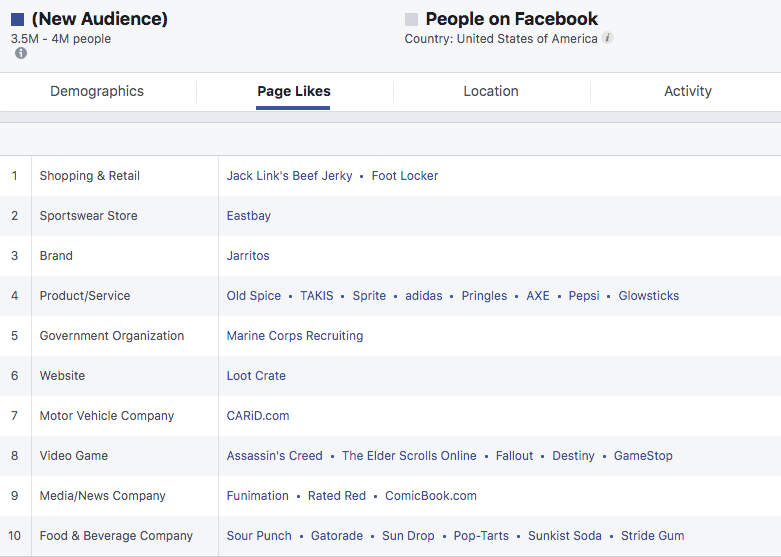
This can help in two ways:
- Creating a more robust audience persona.
- Widen your perspective on what tangential topics and emotions may be relevant to them.
In this case, you see a lot of food and drink brands represented. Perhaps if you’re a comic book store, you create a list of the best/worst junk food and watch the emotional responses of your audience as people vehemently agree and disagree.
As you can see, the more you know about your audience, the more you can tap into potential emotional topics related to their interests.
Predicting the Future by Studying the Past
While simply copying previously successful work that reached your audience isn’t a viable strategy, it’s certainly instructive to see what’s worked before.
If competing brands had big success with campaigns themed around nostalgia or togetherness, you can safely bet that your audience will respond to campaigns that evoke those emotions.
In turn, many audiences may be the most engaged by evoking negative emotions, such as a brand with a strong social justice identity creating a campaign highlighting the scourge of inequality in the workplace.
Whatever the case, emotional marketing can’t succeed without a deep grasp of the actual people who make up your audience — do your homework and you’ll be set up for success in resonating with the people you hope to win over.
For example, if we take the nostalgia route, Disney is a brand that thoroughly understands how nostalgia plays a role with its audience. Many people are often lifelong fans of the brand and its media, showing their children movies they loved growing up themselves.
That’s why it was a genius move to have Christina Aguilera, who sang “Reflection” back when the animated Mulan came out in 1998, sing the song again to promote the 2020 live-action Mulan.
The video has earned more than 3 million views even though it’s the same singer singing the same song. Nostalgia (and Christina’s vocals) can be quite powerful.
So, examine what emotions are resonating with your audiences, and see how you can further tap into those with your future content.
Ideating for Emotional Marketing
Once your emotional marketing research phase is complete, it’s time to figure out how you can provide value in a new way for the most important topical areas you discovered.
The two basic ways to do this in content marketing are:
- Creating on-site, conversion-optimized content.
- Creating off-site, link-building content.
On-site Resource Content Forms an Emotional Identity
The information content on your website forms the backbone of any SEO strategy and provides ample opportunity for your brand to emotionally resonate with consumers while still providing a high conversion opportunity.
One of the best examples of this comes from Toms, the shoe retailer widely known for its substantial philanthropic footprint.
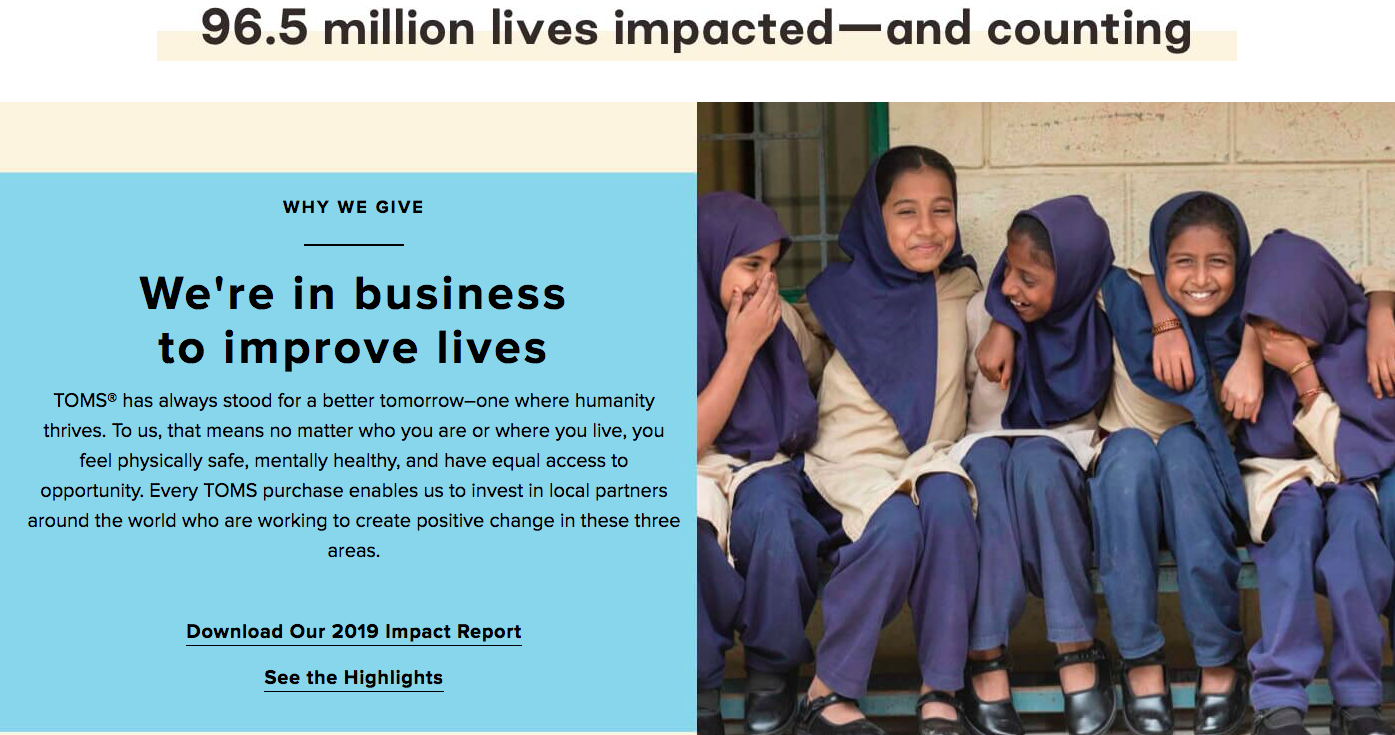
Toms’ website contains an entire section devoted to “Your Impact,” in which the brand tells stories and provides statistics on how its donation programs have affected the lives of millions.
The pages are adjacent to the main e-commerce portions of the page and product links appear throughout the copy, seamlessly integrating the brand’s emotional mission with the core product they provide to consumers.
By presenting social impact as completely intertwined with a purchase, the brand taps into its consumers’ desires to make socially and environmentally conscious purchases while also creating a high probability of conversions.
What you need to do is be sure of your brand’s narrative. What is your brand trying to solve and/or achieve through its product or service offering?
Then speak to the human emotions your target audience has that are associated with those goals.
Link-Building Content Builds an Emotional Connection
Our greatest successes at Fractl have consistently come from understanding a client’s audience and building deeply affecting, emotional content around what mattered to them most.
We wrote in Harvard Business Review not long after our founding about the crucial role an emotional marketing strategy played in our work, and many of our most successful campaigns (such as Your Face as an Alcoholic and Perceptions of Perfection) were built entirely on this idea.
Our emotional marketing research allowed us to know, before even having our first ideation session, the kinds of topics and the feelings that resonated with our target audiences. We also discovered that positive emotions appeared most in the viral content we studied — surprise being the most prevalent.
Creating emotional content provides a chance to build authority, generate brand awareness, and contribute value in a minimally branded, holistic way. Content that elicits strong emotions or conveys knowledge while not directly explaining the value proposition can achieve a whole different level of emotional resonance: They are stories and journalism first, advertising second.

By creating experiences that users would flock to regardless of whether they were hosted by a brand or a major online media outlet, we earned tens of thousands of high-quality backlinks for our clients while also establishing their credibility and place in the hearts and minds of their audiences.
Emotional Marketing and Real Connection
Emotional marketing attracts an audience, promotes your brand, and makes you memorable. By creating content that’s aimed not just at the mind but at the heart, you’re sure to delight existing followers and attract plenty of new ones. Audiences want to be moved and they want to be engaged by more than the simple value proposition of your product.
To successfully practice emotional marketing, you need to know who your audience is and the ways you’re most likely to reach them. With this knowledge in hand, you can align emotional marketing campaigns with your overall digital marketing goals and strategies, producing a comprehensive marketing vision for your brand that engages a wide audience with engaging and effective content.

